
July
2016 |
 |
|
|


The Past Is Never Dead. It's Not Even Past.
Faulkner's famous quote is perfectly exemplified by the First World War, especially 1916. It's not past, not Verdun, not the over-hyped dreadnoughts of Jutland, and not the Romanov and Habsburg empires that accelerated their death spirals in the Brusilov Offensive during the summer. This month we will be recalling the signature battle of the war for the English-speaking world — the Battle of the Somme. Recall, it was the agonizing memory of the Somme that made Winston Churchill so reluctant to support a cross-Channel invasion in the Second World War.
More recently — and I don't have a shred of evidence to support this — my instincts tell me that deep, distant memories of the Somme had something to do with the recent Brexit referendum, although I don't know if that was for one side or the other, or both. [Please don't write, I have no way to back this up. It's my lizard brain speaking.]
In any case, it's not just the Somme that gives 1916 its big historical footprint. Last month, for instance, Germany and France once again met on the Verdun battlefield, apparently to make a political statement. With Chancellor Merkel and President Hollande watching approvingly, the hallowed ground of the French National Cemetery, overlooked by the mournful Ossuary, was used for a mock battle conducted by 3,400 young people. They divided into two groups and lined up facing one another from either end of the huge burial site. At a signal, these opposing battalions, lacking any vulgar and passé nationalistic regalia, but exquisitely balanced by sex and ethnicity, charged each other over the graves, through the cemetery's 15,000 crosses, Stars of David, and Muslim steles, and then symbolically massacred each other. Thousands of mock corpses were soon strewn across the graves holding the fallen of the real Battle of Verdun.
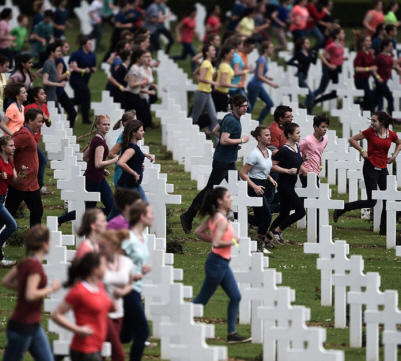
Charge!
(In Case You Thought I Was Making This Up)
Unlike 1916, though, when everyone killed at Verdun stayed dead, through the agency of some magical element (music or pixie dust, I couldn't tell on the YouTube video) the recently deceased surprisingly next found themselves resurrected. The conclusion of the affair featured several thousand teenagers intermingling and embracing as one huggy, happy, highly diverse, and borderless congregation. On the podium the two most influential leaders of the EU beamed. Verdun 1916 — neither dead, nor past — had valuably served a present-day purpose, as a platform for portraying an idealized neo-Europe for the 21st century.
MH

|
2016 Events
2016 National WWI Symposium
The World War I Historical Association, the General Douglas MacArthur Foundation, and the World War One Centennial Commission are holding this year’s event on 21-22 October in Norfolk, VA. This year’s theme is “1916: Sex, Planes, and Disasters.” DETAILS
League of WWI Aviation Historians — Mid-Atlantic Chapter Meeting
Saturday – September 17th, 2016, 10:00am-5:30pm at the
National Air and Space Museum’s Steven F. Udvar-Hazy Center On the Hangar Floor Level. Topics include the Caproni bomber, air warfare at Verdun, and historical research for aircraft modelers. (email for details)
|
|
1916 — 1 July — 2016
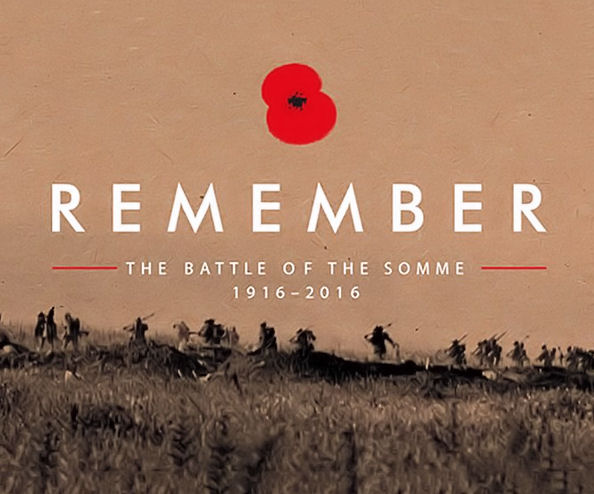
Royal British Legion Poster (Detail)

A Somme Primer

The River Somme
Kind of Peaceful Looking. Isn't It?
I wanted to provide our readers with a list of online sources that could provide a little brush-up on the Battle of the Somme for our regular readers, or an introduction for anyone just starting to learn about the Great War. I searched around, and some of the very best material is located at our very own blog, Roads to the Great War. Here's a starter set of articles for you:
 Animated Map and Chronology of the Battle of the Somme
Animated Map and Chronology of the Battle of the Somme
 The Terrain of the Somme
The Terrain of the Somme
 The Preliminary Bombardment
The Preliminary Bombardment
 The French Contributions
The French Contributions
 The Legendary Soccer Balls of the Somme
The Legendary Soccer Balls of the Somme
 Case Study, the Somme Extended: The South African Brigade at Delville Wood
Case Study, the Somme Extended: The South African Brigade at Delville Wood
 Quotes about the Battle of the Somme
Quotes about the Battle of the Somme
 Sites of Remembrance on the Somme Battlefield
Sites of Remembrance on the Somme Battlefield

The Term "Shell Shock"
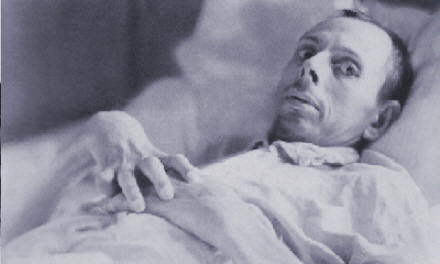
WWI Victim of What We Call PTSD
A British psychologist, Charles S. Myers, first used the expression "shell shock" in the medical journal Lancet on 13 February 1915. His article did much to dramatize the problem of wartime psychiatric casualties.
Later, though, Myers's theory that war neurosis had a physical cause (shell blast) was discredited, but the term stuck throughout the First World War.

WWI & European Self-Loathing
The Europeans, "torch bearers of civilization," are eating at each other, trampling down civilization, ruining Europe; and who will be the better? It is like an avalanche, growing ever more ravaging, as it falls sweeping away trees, woods, homesteads, farms. The catastrophe gets greater and greater. All know the avalanche will consume the valley but no force can stop it . . . European civilization has failed — it was rotten to the core.
Future Nobel Laureate Fridtjof Nansen of Norway, 1916
|

|

U.S. Centennial Organizations & Resources
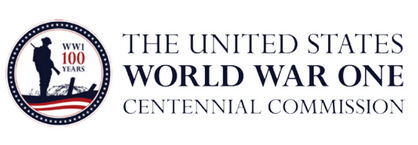
worldwar-1centennial.org/
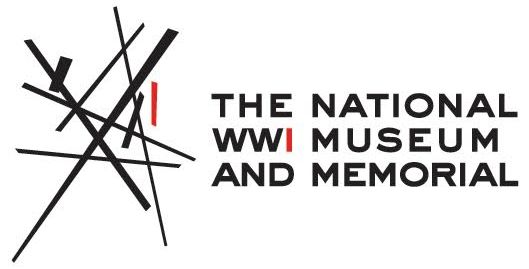
theworldwar.org/
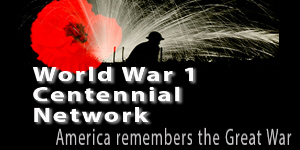
www.ww1-centennial.org/
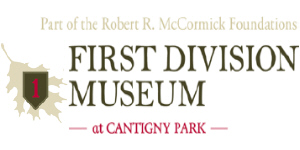
www.firstdivisionmuseum.org/

www.abmc.gov/
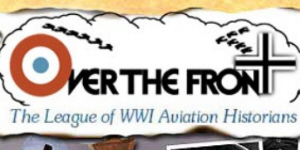
www.overthefront.com/

www.nationalmuseum.af.mil/
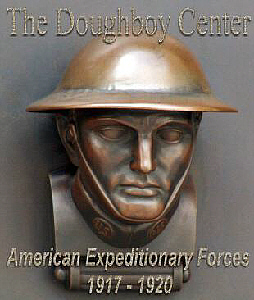
www.worldwar1.com/dbc/
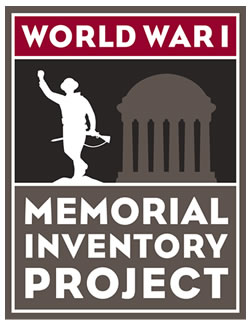
facebook.com/wwiinventory

wisconsinhistory.org/

www.uswarmemorials.org/
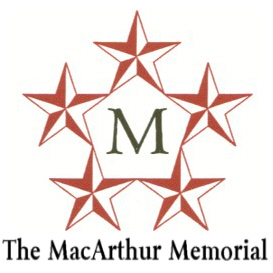
www.macarthurmemorial.org/

www.saving-hallowed-ground.org/
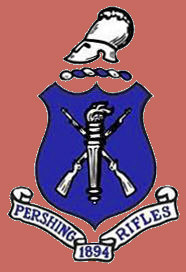
www.theprgroup.org/
Support Worldwar1.com's Centennial Effort
Shop at Amazon.com
|
The Centennial Ticker
Western Front Association, East Coast USA
Spring Symposium
From Correspondent Steve Miller
On Saturday, 11 June, 2016, the Western Front Association East Coast Branch (USA) gathered at the historic Maryland War Memorial Building in Baltimore for an exciting day-long program featuring authors and speakers on First World War history topics, displays of WW1 artifacts, door prizes and networking among WW1 history enthusiasts. Symposium speakers presented a variety of excellent, interesting subjects including little-known aspects of WW I, and controversial viewpoints to stimulate further research and discussion.
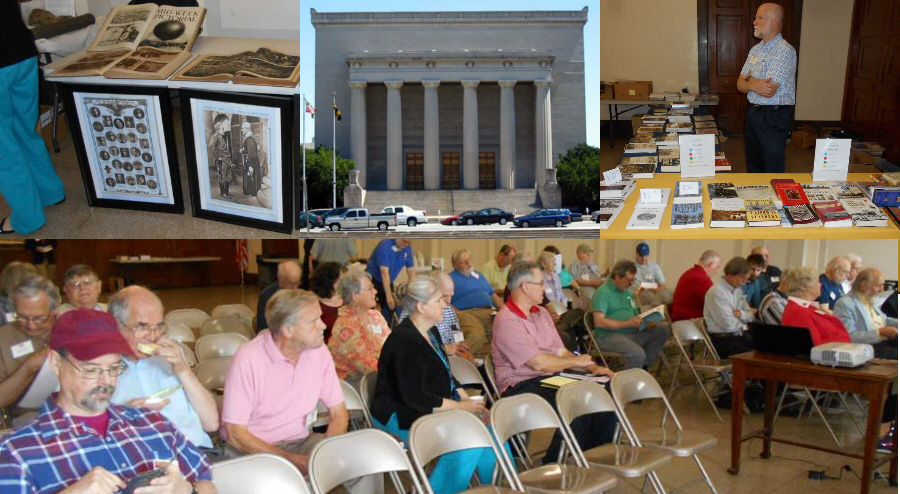
The Maryland War Memorial Venue Flanked by Artifact and Book Displays; Below: the Audience
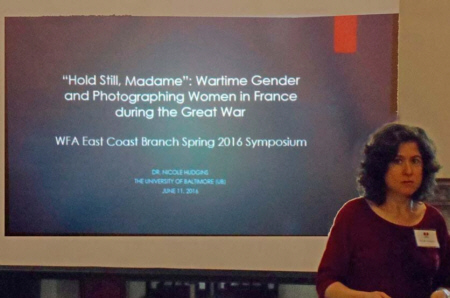
"Hold Still, Madame", by Dr. Nicole Hudgins. I anticipated some racy French postcards, or pinups like Betty Grable, or Joan of Arc waving the tricolour and leading the charge against the hated Boche. Instead, the photographic propaganda featured women of the home front: in distress at the loss of their husband or sons, feminine devotion, and women toiling for the war effort. How Madame served her family and the nation while Papa was battling the enemy, and some becoming pen-pals for some lonely Poilu. Click on title to order
Hold Still, Madame: Wartime Gender and the Photography of Women in France During the Great War
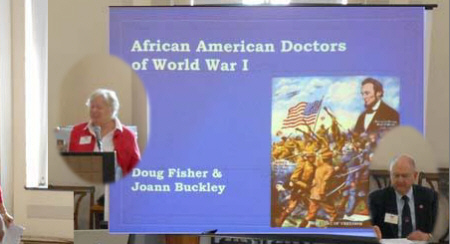
Doug Fisher & Joann Buckley's African-American Doctors of World War I discussed the 104 black physicians assigned to care for the 40,000 men of the 92nd and 93rd Divisions, the Army's only black combat units. Aside from being overworked, these men had to cope with the racial attitudes of a segregated Army. 1st Lt/Doctor Urbane Bass was KIA 17 October 1918 while attending wounded soldiers. Bass is buried in the Fredericksburg National Cemetery. Click on title to purchase,
African American Doctors of World War I: The Lives of 104 Volunteers . .
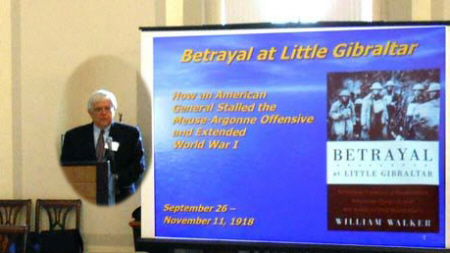
William Walker's Betrayal at Little Gibraltar was a thought-provoking discussion of the battle for Montfaucon. He advocates Major General Bullard's failure to follow orders cost many American lives and possibly prolonged the war. Rather than being cashiered, Bullard was saved by Pershing and "the West Point Protective Association." Was Montfaucon a major victory or a major cover-up? Purchase Betrayal at Little Gibraltar HERE
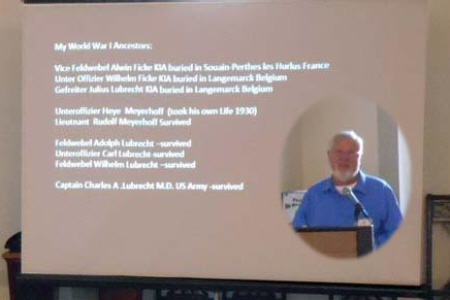
Liebe Kück ("Beloved Cuckoo"), according to my German-English Dictionary, although "My dearest little bird" might be closer to the emotion. Vice Feldwebel (Staff Sergeant) Alwin Ficke of the 74th Reserve German Infantry was one of Peter Lubrecht's ancestors during the Great War, killed in France in February 1915. Lubrecht's book is based upon Ficke's letters to his wife and family. It contradicts much of the early German wartime propaganda, providing a "down in the trenches" realistic look at the conflict. Liebe Kück found HERE.
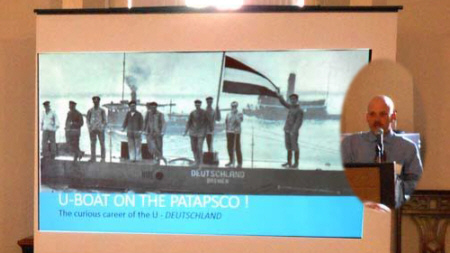
Branch Chairman Paul Cora presented "U-Boat on the Potapsco". The Deutschland was a cargo submarine, designed to circumvent the British sea blockade. It visited the USA while America was still neutral in a desperate effort to obtain needed supplies for the German economy and to "show the flag" in a country with a large German-heritage population. The U-boat sailors operated in unbearable conditions, and the cargo capacity was inadequate in comparison to surface shipping. Just click on the title to order the Naval Institute Press's book, The Merchant U-Boat: Adventures of the Deutschland, 1916-1918

Support the National World War I Memorial at Pershing Park

The Goal #l for America's World War I Centennial Commemoration is building the new memorial at Pershing Park in Washington, DC. A beautiful design has been selected and now we need to get it built. That final step is going to be a big $$$$$$$ ticket item, and millions of dollars need to be raised to achieve it. See this brief video that is part of the Commission's Fouth of July roll-out for their fund-raising effort: VIDEO LINK
As part of their fund-raising effort, the Centennial Commission has opened a store where you can purchase Doughboy themed items including apparel, posters, memorabilia, books, authentic gear, and even the humble bumper sticker shown above. Proceeds from every sale will help the fund to build the long overdue monument to those who served our country in the Great War.
Shop Here
More on Memorial Day 2016
Our article last month encouraged readers to send in more information on Memorial Day events. Here are two images I thought you might enjoy:
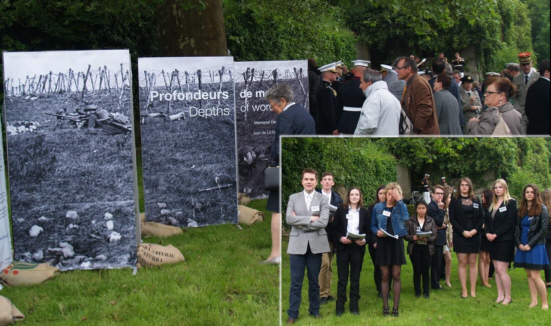
WWI Commissioner Jerry Hester sent this photo of a group of French students (insert) who were guests of the U.S. Marine Corps at the annual Belleau Wood commemoration. Their project involved incorporating an actual historical event into their stories accurately. Marine Commandant General Robert Neller was impressed with their work.
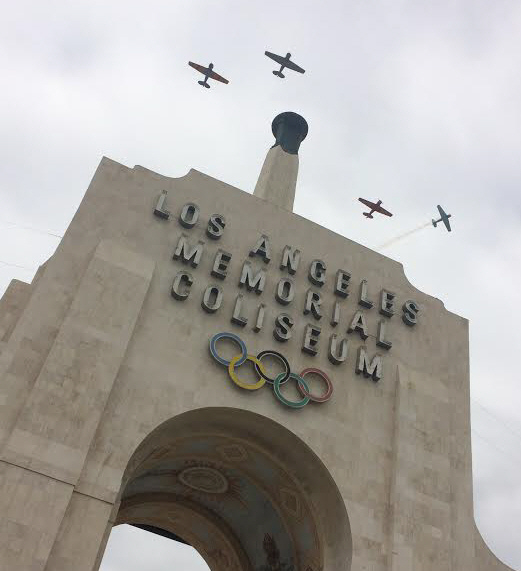
Commission Volunteer Courtland Jindra sent this photo of the flyover on Memorial Day at the Los Angeles Memorial Coliseum. It should be remembered that the Coliseum is dedicated to all the nation's fallen of the war.
|
|

1 July 1916: The Battle of the Somme Begins
For the English-speaking world, the Battle of the Somme is the signature battle. The first day of the battle — so disastrous for the British Army — will be remembered over and over this week. I think the more important thing to reflect on, though, is that after the failed breakthrough attempt of the first day, the fighting seamlessly became a war of attrition. Those 60,000 casualties for the British Army of the first day would be multiplied by seven over the next months. German losses would be similarly astronomical. The forgotten French contingent would lose men at roughly the same rate as in the concurrent fighting at Verdun. Lucky for France, the Somme lasted only half as long as Verdun.
As one German soldier described it: "The tragedy of the Somme battle was that the best soldiers, the stoutest-hearted men were lost; their numbers were replaceable, their spiritual worth could never be."
We have provided links to a number of good articles in our "History on the Web" feature above and will be discussing the extended Battle of the Somme throughout the year, but since the tragedy of the First Day on the Somme has gathered symbolic, even mythological significance, we have chosen to begin our coverage of the battle with a montage of then and now images that, we hopecollectively helps the reader understand the meaning of 1 July 1916 a century later.
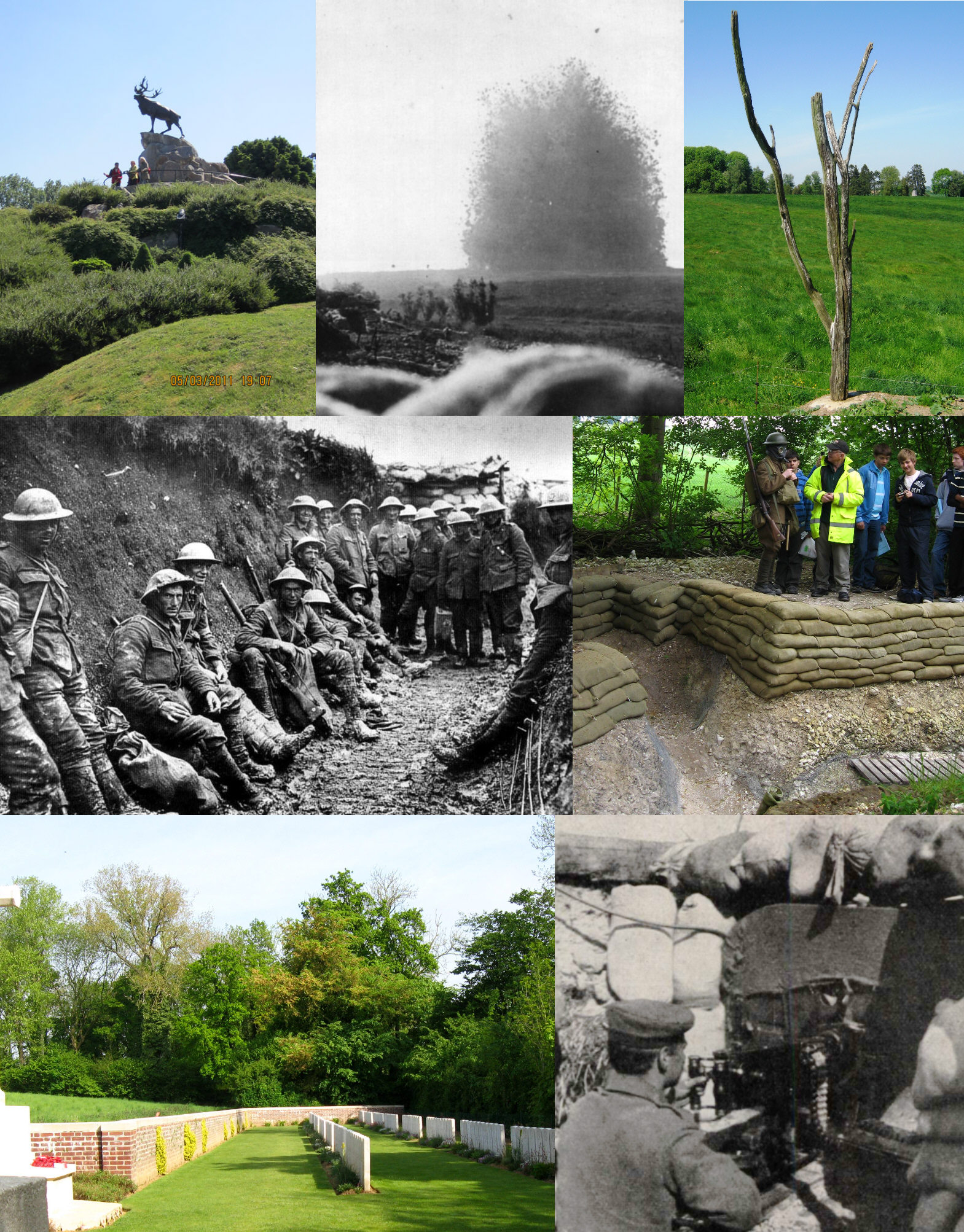
Top Row: Three scenes from around Newfoundland Memorial Park. The caribou statue surveying the trenches symbolizes the Newfoundland Regiment that went over the top here in the third wave on 1 July and suffered almost 90 percent casualties in minutes. Earlier and close by was the explosion of Hawthorne Mine under German lines that the Lancashire Fusiliers were unable to exploit. Blown before the signal to attack, it warned German troops in deep bunkers that the assault was imminent. A replica of the "Danger Tree" stands in the old battlefield's No-Man's-Land. It was part of a group of trees that provided the only apparent cover in the area. Soldiers crawled toward them, but they were still easy targets.
Middle Row: A pensive-looking group of Irish soldiers from the 8th Division during a lull (for them) on 1 July. School children visiting the restored trenches of Thiepval Wood from which the 36th "Ulster" Division advanced that day in an attempt to capture the Schwaben Redoubt. They advanced impressively but then found themselves isolated and vulnerable on the ridge.
Bottom Row: The Devonshire Cemetery near the hottest spot on the 1 July battlefield near Fricourt village holds the remains of the men who left their trench on that very location and were machine gunned down just in front of it. At its entrance is posted the inscription "The Devonshires Held This Trench; The Devonshires Hold It Still." The last image is of a typical German machine gun emplacement, the type of which inflicted the majority of the casualties of the First Day on the Somme.
|
|

Announcing Our 2017 Centennial Battlefield Tour Schedule

2017 Program
Valor Tours is happy to announce its 2017 World War I Centennial Battlefield Tours. Our brochure is currently in preparation — subscribers to the Trip-Wire will receive it via email as soon as it is ready. Just click on the "Sign Up" button on the top of the page if you haven't registered yet. Here are some details for you:
8 – 15 May 2017: Flanders 1917 Campaign
Includes: Vimy Ridge, Messines, and Passchendaele
24 July – 3 August 2017: Caporetto and the Italian Front
Includes: The Eleven Battles of the Isonzo, Caporetto 1917, Monte Grappa, and the 1918 Line
The full brochure covering the trip and registration details can now be downloaded at:
http://www.worldwar1.com/pdf/ValorTours_2017Flyer.pdf
Remaining 2016 Program
14 – 21 August 2016: The Somme In-Depth
Visiting includes all the famous stops, plus the Hawthorne mine Crater, the Soccer Balls of the Somme site, and Where Alan Seeger Met His "Rendezvous."
Rooms Still Available on our 2016 Somme Tour. The full brochure covering the trip and registration details can now be downloaded at:
http://www.worldwar1.com/pdf/ValorTours_2016Flyer.pdf
|
|
|

|

A Great Literary Blog
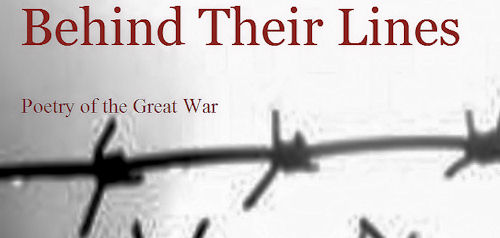
by Connie Ruzich
Usually we present our recommended books on the Trip-Wire, and recommended blogs on our blog Roads to the Great War. I think I've been slow to recognize, however, that not all Trip-Wire readers read our blog and vice-versa. In the future, I plan to do more cross-fertilization of our sites and I'm starting in this issue. One of the very best literary blogs is produced by our friend Connie Ruzich, who is a dedicated connoisseur of the "lost voices and faded poems" of the Great War. Last year, we presented one of Connie's articles on Roads. . . (HERE). Here is a more recent entry. If you enjoy it, please subscribe to Connie's blog by following the link below.
Wrestling with God
It is commonly accepted that one of the casualties of the First World War was belief in God. By the second year of the war, the British public was growing to resent Church of England clergy who supported the war and encouraged others to enlist while they remained safe in their pulpits.
The Bishop of London, Arthur Winnington-Ingram, was one of the most enthusiastic war promoters, and his hatred of Germany was so vociferous that even Prime Minister Asquith described the bishop’s rhetoric as “jingoism of the shallowest kind.”
However, approximately 3,000 of the 25,000 Church of England clergy did enlist and accompany troops to the front as military chaplains; they were likely as diverse as the men they served. Some were scorned, others were loved. Robert Graves, in his memoir Goodbye to All That, accused Anglican chaplains of being cowardly and out-of-touch, while other soldiers wrote admiringly of regimental chaplains who not only lived with their men, but also risked everything to go “over the top” with their units and assist with the wounded.
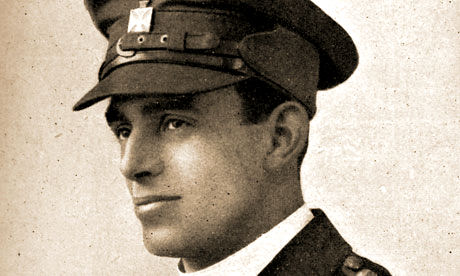
Geoffrey Studdert Kennedy
Geoffrey Studdert Kennedy was one of the beloved chaplains of the war, known to the troops as Woodbine Willy for his habit of offering cigarettes to the men in his care. Serving in France from December of 1915 until 1919, Studdert Kennedy was also a war poet. His writings frequently grapple with doubts and questions as he attempts to distinguish between clichés of faith and an authentic spirituality.
As the war dragged on, it became increasingly difficult to see the presence of a loving God in the relentless suffering and death. But unlike other war poets who criticized and dismissed the Christian faith as an empty sham, Studdert Kennedy, like Jacob, wrestled with his God for answers that could stand up under harsh scrutiny.
His poem “Solomon in All His Glory” alludes to the brevity of human life, while affirming the dignity and beauty of each individual’s sacrifice that breaks the heart of God.
Solomon in All His Glory
Still I see them coming, coming,
In their ragged broken line,
Walking wounded in the sunlight,
Clothed in majesty divine.
For the fairest of the lilies,
That God's summer ever sees,
Ne'er was clothed in royal beauty
Such as decks the least of these.
Tattered, torn, and bloody khaki,
Gleams of white flesh in the sun,
Raiments worthy of their beauty,
And the great things they have done.
Purple robes and snowy linen
Have for earthly kings sufficed,
But these bloody sweaty tatters
Were the robes of Jesus Christ.
— GA Studdert Kennedy
|
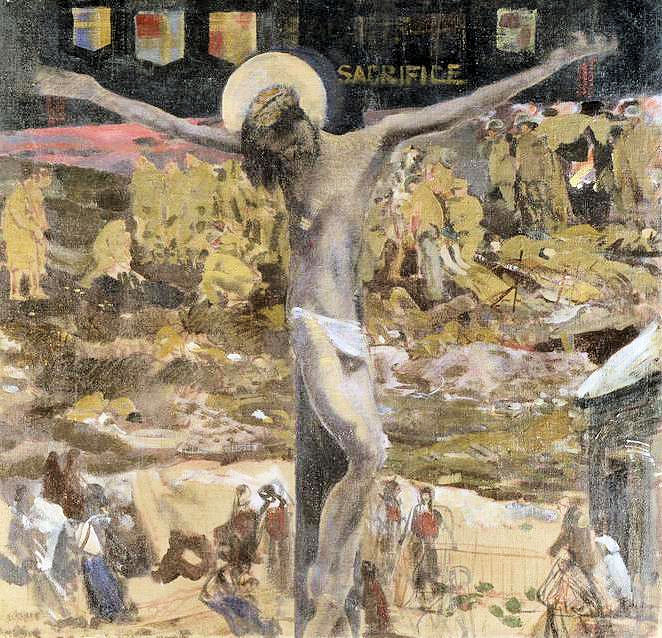
Sacrifice
Charles Sims,
IWM Collection
|
The poem gazes unflinchingly at the suffering of the men at the front: “Still I see them coming, coming.” It bleakly catalogues the bloody wounds, the torn uniforms, and the immensity of misery as evidenced by the ragged line of walking wounded that stretches out of sight. And yet the poem also dares to speak of beauty and glory.
Continue reading Connie's "Wresting with God" and subscribe here: Behind Their Lines, 21 June 1916 Entry
|

The Model T Goes to War
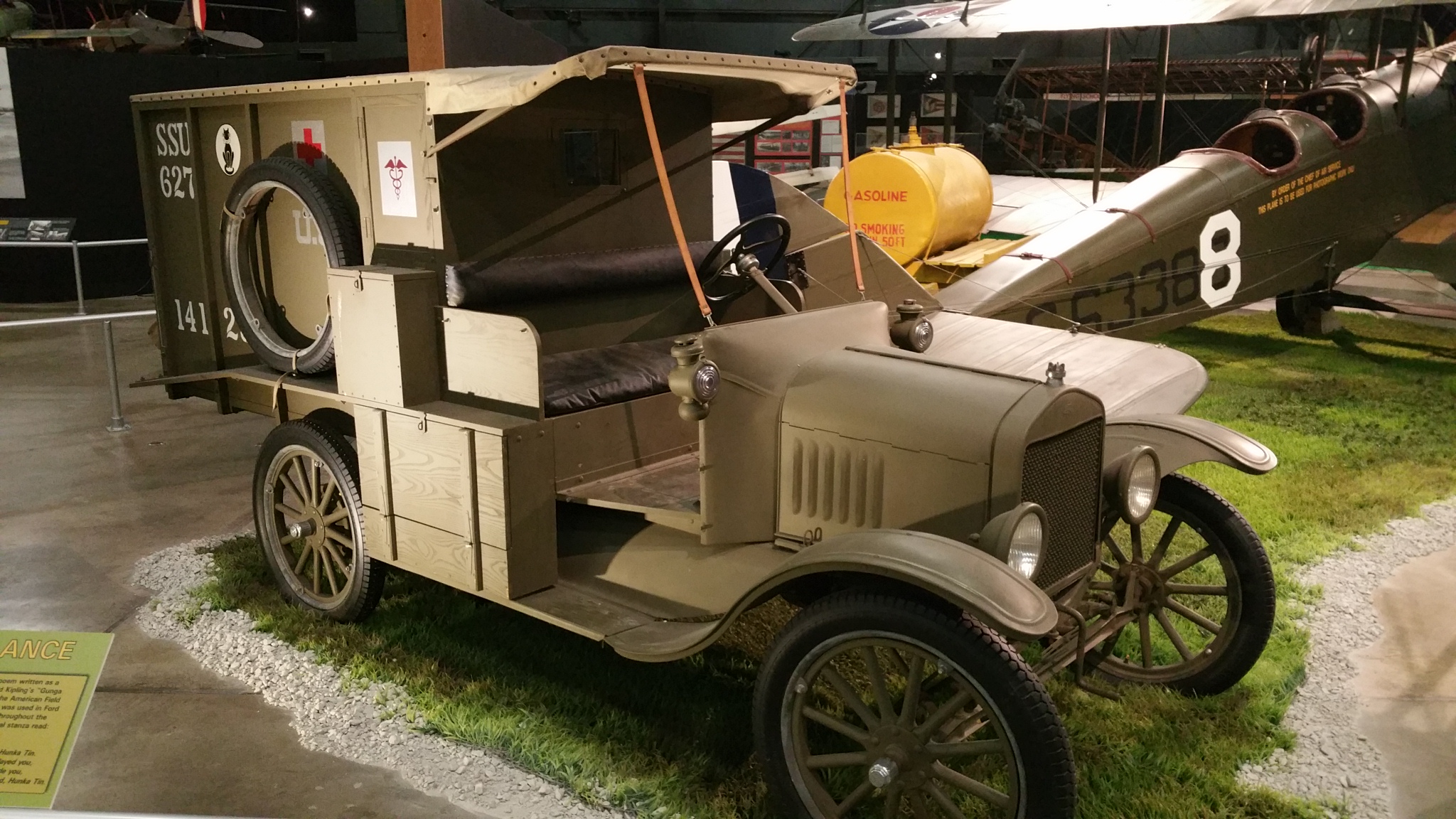
One of Henry Ford's Ambulances at the USAF National Museum
During World War I, the Allies used thousands of Model T cars and trucks because of their low cost and ease of repair. The ambulance version's light weight made it well-suited for use on the muddy and shell-torn roads in forward combat areas. If stuck in a hole, a group of soldiers could lift one without much difficulty. By 1 November 1918, 4,362 Model T ambulances had been shipped overseas.
The light wooden body was mounted on a standard Model T auto chassis. The 4-cylinder engine produced about 20 hp. There was no self-starter; the engine had to be cranked by hand. This vehicle was equipped with an early form of automatic transmission and could carry three litters or four seated patients and two more could sit with the driver. Canvas "pockets" covered the litter handles that stuck out beyond the tailgate. Many American field service and Red Cross volunteer drivers, including writers Ernest Hemingway and Bret Harte and cartoonist Walt Disney, drove Model T ambulances.
"Hunka Tin," a poem written as a parody on Rudyard Kipling's "Gunga Din," appeared in the American Field Service Bulletin and was used in Ford dealers' advertising throughout the United States. The final stanza read:
Yes, Tin, Tin, Tin.
You exasperating puzzle, Hunka Tin.
I've abused you and I've flayed you,
But by Henry Ford who made you,
You are better than a Packard, Hunka Tin.
In addition to the specimen shown here, which is at the U.S. Air Force National Museum, you can also see examples at the National World War I Museum in Kansas City and the Walt Disney Family Museum at the Presidio of San Francisco.
|
|

Japan's Imperial Navy in the Mediterranean
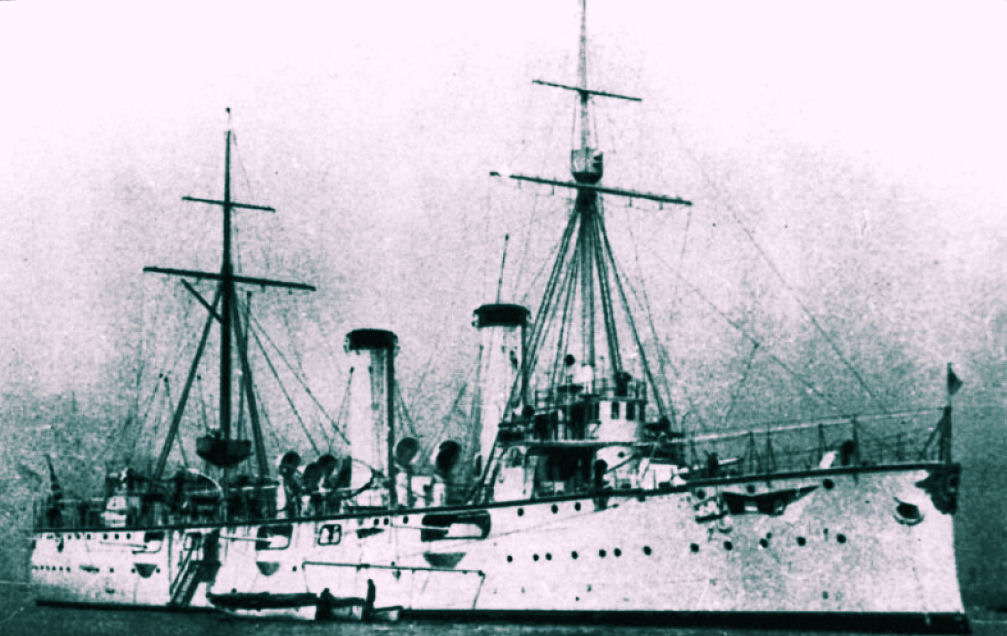
Cruiser Akashi, First Flagship of the Mediterranean Squadron
By 1917, German and Austrian submarines operating in the Mediterranean were sinking Allied shipping at an alarming rate. Of the approximately twelve million British registered tons (BRT) of shipping lost during the war, 3,096,109 tons fell prey to mines and submarines in the Mediterranean. Despite ill-placed misgivings about the quality of Japanese seamanship, the Allies pressured Japan to help out. What was needed were more escort ships like destroyers.

Admiral Kozo |
On 11 March 1917, Admiral Sato Kozo aboard the cruiser Akashi and eight destroyers comprising the Second Special Squadron left Singapore headed west and arrived at Malta, in the middle of the Mediterranean Sea on 13 April. The arrival of Sato's cruiser and eight destroyers did not by itself tip the scales toward the Allies
in the Mediterranean. Nonetheless, the task given the Japanese squadron was an important one — protecting troop transports shifting vital reinforcements to France after the bloody offensives at
Arras, Chemin des Dames, and in the Champagne. The appearance of Japanese escorts at
Malta permitted the Allied command to speed the passage of transports. Japanese vessels escorted
the transports directly from Egypt to France without stopping at Malta except when convoys
formed at that port.
The destroyers Sakaki and Matsu and other Japanese warships participated in the dramatic rescue
of troops from the torpedoed transport Transylvania on 4 May 1917. Some 413 men died in this
tragedy off the French coast, but Japanese, French, and Italian naval forces saved most of the
three thousand troops despite the danger of further torpedo attack.
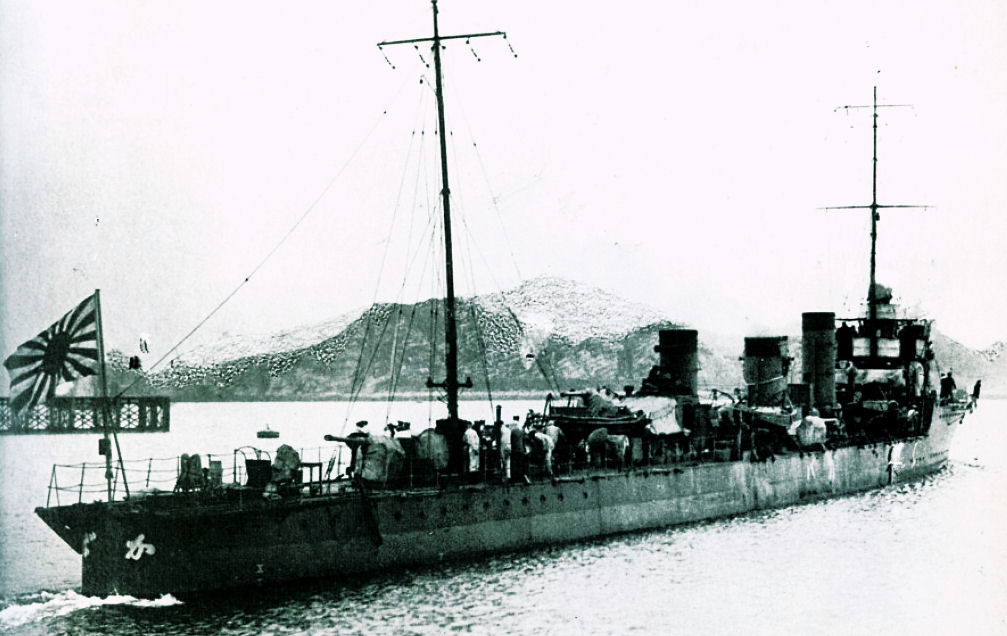
Kuba-Class Destroyer
The Japanese navy relieved the Akashi in June 1917 with the armored cruiser Izumo and
reinforced the Malta squadron with the destroyers Kashi, Hinoki, Momo, and Yanagi. As the
tempo of anti-submarine operations in the Mediterranean accelerated, Japanese sailors
temporarily manned two British gunboats, which they designated the Tokyo and Saikyo, and two
British destroyers, renamed the Kanran and Sendan. At peak strength in 1917, the Japanese
Mediterranean flotilla numbered 17 warships.
Source: Anglo-Japanese Naval Cooperation, 1914-1918 by Timothy D. Saxon
|
|
|
Thanks to each and every one of you who has contributed material for this issue. Until our next issue, your editor, Mike Hanlon. |
|
 (Or send it to a friend)
(Or send it to a friend)
|
Design by Shannon Niel
Content © Michael E. Hanlon
|
|
|




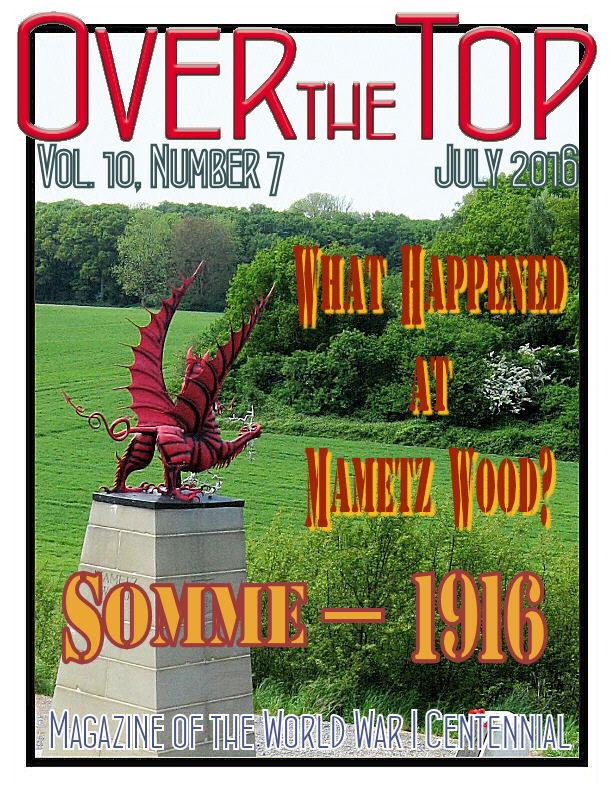



![]() Animated Map and Chronology of the Battle of the Somme
Animated Map and Chronology of the Battle of the Somme
![]() The Terrain of the Somme
The Terrain of the Somme
![]() The Preliminary Bombardment
The Preliminary Bombardment
![]() The French Contributions
The French Contributions
![]() The Legendary Soccer Balls of the Somme
The Legendary Soccer Balls of the Somme
![]() Case Study, the Somme Extended: The South African Brigade at Delville Wood
Case Study, the Somme Extended: The South African Brigade at Delville Wood
![]() Quotes about the Battle of the Somme
Quotes about the Battle of the Somme
![]() Sites of Remembrance on the Somme Battlefield
Sites of Remembrance on the Somme Battlefield



























